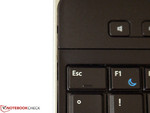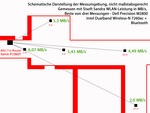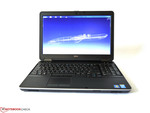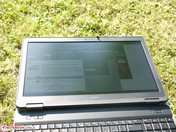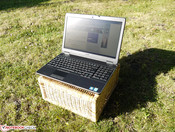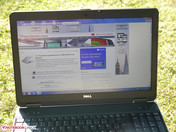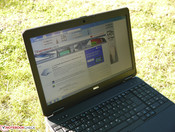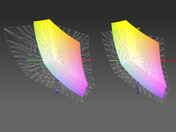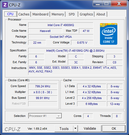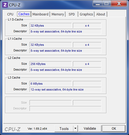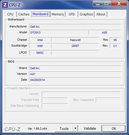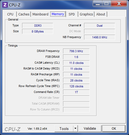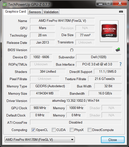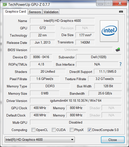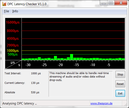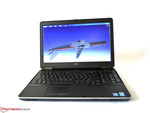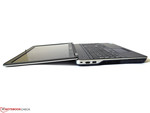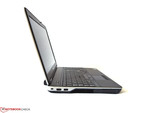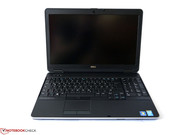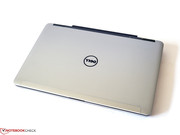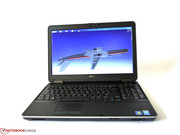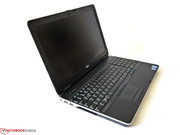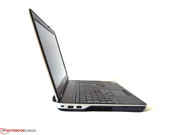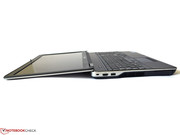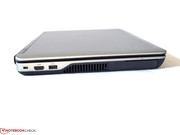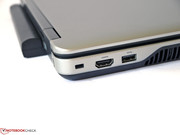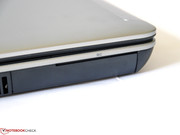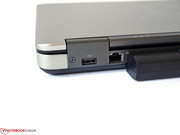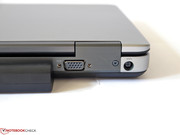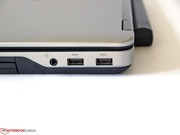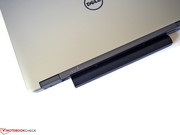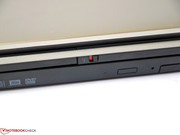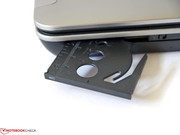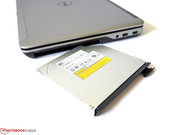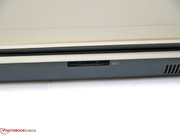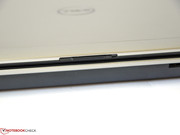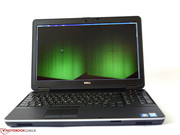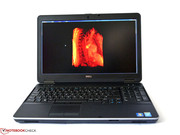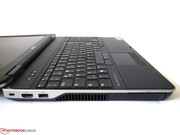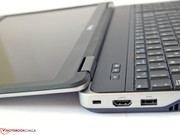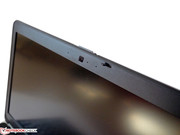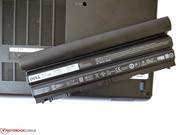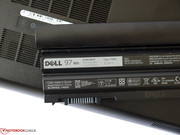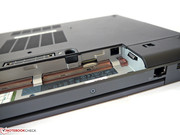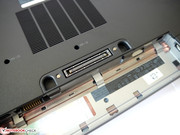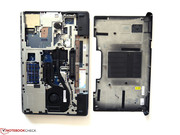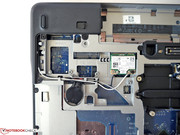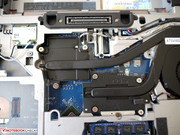Dell Precision M2800 Notebook Review

For the original German review, see here.
Dell uses familiar components for the new Precision M2800 and utilizes the case of the Dell Latitude E6540. Besides its robust construction, it offers good expandability and was designed for professional purposes. With updated components and the professional graphics card AMD FirePro W4170 GPU, Dell upgrades the Latitude to the Precision Workstation. This is a clever and inexpensive approach to expand its product portfolio. This solution is not unfamiliar, Dell already successfully used this concept in the case of the Dell XPS 15 UltraBook for the Dell Precision M3800.
Our review unit is the current top version of the Precision M2800-series. For around 1,800 Euros (~$2455) you get an Intel Core i7-4810MQ CPU, AMD's FirePro W4170 GPU, 8 GB RAM, a 128 GB Solid-State Drive and a matte Full HD panel.
Case
As mentioned before, the case of the Precision M2800 is identical to the Latitude E6540. The Tri-Metal construction is very sturdy and once again leaves a very solid impression. The palm rest is firm, the chassis very torsion-resistant and the hinges have no problem keeping the display in position. However, some details of the build quality are not so great. You can sometimes see parts that are not perfectly integrated and uneven gaps.
The weight of our review unit is slightly above average for 15-inch workstations weighing 2.9 kg (~6.4 pounds) and it is much heavier than the Lenovo ThinkPad W540, for instance. You can save some weight with a smaller battery and a dummy for the optical drive, but it will limit the features significantly. More impressions of the case are available in the review of the Dell Latitude E6540.
Connectivity
The port variety covers all the important aspects, but we still miss some typical business ports. HDMI and 4x USB 3.0 are more common for consumer notebooks. DisplayPort, eSATA or FireWire on the other hand can only be used via ExpressCard. Thunderbolt is currently not available. The port layout is very convenient and the majority of ports are at the rear area of the sides or the back of the device. The card reader is at the front and easy to use.
Communication
The core component of the communication modules is Intel's Dual-band Wireless-AC 7260. It supports the fast 802.11ac standard with a theoretical transfer rate of up to 867 Mbps. We determined good signal quality with a stable connection in our practical test. We measured WLAN performance of up to 6 MB/s with an 802.11n router and there were no unusual connection drops or range issues. Besides the mandatory webcam, Bluetooth 4.0 and a Gigabit-LAN port you also get an empty slot for a WWAN module. The necessary antennas are already integrated, so an upgrade should be no problem. You can also use this slot for an mSATA SSD.
Security
Besides the usual password protections for the BIOS, the system and the files, our review unit is also equipped with a drop sensor, a SmartCard reader and Dell's security tool Protected Workspace. The Trusted Platform Module and the Computrace support are integrated, but have to be activated in the BIOS first. A fingerprint reader is not available. You also cannot select it as an option in the online store, but it should be configurable according to Dell. The manufacturer actually offers several additional features apart from the less expensive configurations in the online store, which should be interesting for small and large companies in particular.
Accessories
Dell's Precision M2800 can use all the accessories from the Dell Latitude E6540. Especially the system-specific program is interesting, which includes docking stations, batteries, optical drives and modules. This can be a big advantage and save additional costs if you already have the related devices.
Maintenance
You can easily remove the bottom cover after you loosen some screws. This gives you comfortable access to the most important components. Some parts like the system memory, the WWAN/mSATA slot, the primary storage solution and the modular drive bay can be upgraded. The fan is accessible and can be cleaned or replaced if necessary.
Warranty
Dell equips its Precision M2800 Workstation with a three-year warranty (Base Support on the next business day). As usual, Dell offers several extensions and upgrades. Such an extension of the base support to 5 years, for instance, is available for almost 108 Euros (~$147, net).
Input Devices
Keyboard
The keyboard uses almost the whole width of the case and has conveniently sized keys. Even the arrow keys are comparatively large and are easy to use. Spreadsheet users will be happy about the separate numeric keypad, which improves the input of large number rows significantly. Besides a high-contrast lettering, the input also has a background illumination that can be adjusted in four steps. Dell is very restrained with FN functions and only integrates a couple of them with a blue lettering. The keyboard is very firm, has an average travel and a convenient stroke. Frequent writers should have no problems with this input.
Touchpad
The size of the touchpad (80 x 43 mm; 3.1 x 1.7 in) suggests that it is an older model. There is not a lot of room for gestures with multiple fingers. Otherwise we like the input very much – gliding capabilities, response and the handling do not cause any criticism. The separate buttons have a convenient rubber coating and work flawlessly. They can also be configured according to your own needs and combined with the TrackPoint buttons. The corresponding TrackPoint works precisely as usual and is a convenient alternative, especially with limited space like on a train ride or on the plane.
Display
Dell currently only equips the Precision M2800 with a matte Full HD panel with the TN technology. There will not be an IPS panel or a version with a very high resolution in the foreseeable future. Even though TN displays have drawbacks in certain areas, the CMO panel in our review unit is undoubtedly one of the better versions.
| |||||||||||||||||||||||||
Brightness Distribution: 72 %
Center on Battery: 278 cd/m²
Contrast: 897:1 (Black: 0.311 cd/m²)
ΔE ColorChecker Calman: 9.95 | ∀{0.5-29.43 Ø4.79}
ΔE Greyscale Calman: 11.25 | ∀{0.09-98 Ø5}
59% AdobeRGB 1998 (Argyll 1.6.3 3D)
52.4% AdobeRGB 1998 (Argyll 3D)
72.9% sRGB (Argyll 3D)
51.2% Display P3 (Argyll 3D)
Gamma: 3.45
CCT: 10110 K
The measured average brightness is on a good level with 281 cd/m², but the brightness distribution of just 72% is not very convincing. The bad result is caused by the high brightness difference of around 90 cd/m² between the brightest and the darkest point. However, this difference is hardly visible in practice, even with plain backgrounds. The luminance can be adjusted in 15 steps from 33 cd/m² all the way up to 279 cd/m² (in the center). Step 8 results in 163 cd/m², which we will use for some battery runtime tests.
You can comfortably work outdoors thanks to the high brightness, the matte surface and the good contrast. Only direct sunlight should be avoided since it will strain your eyes.
As mentioned, the contrast of 897:1 is above average and provides deep blacks and rich colors. Pictures, movies and games benefit the most from this, but text documents and web pages look nicer compared to standard displays as well. The available colors can represent the sRGB color space by around 65%. This is obviously sufficient for many tasks, but not for graphic artists, photographers or web designers.
While the color accuracy is not suited for professional tasks ex-works, the situation is much better after calibration. The gamma curve is almost perfect, just like the RGB balance. The grayscale and the color accuracy of the ColorChecker only show a DeltaE 2000 deviation of more than three in two cases. You can only see the limited color space when you look at the primary colors since they lose some accuracy. The largest DeltaE 2000 deviation is just above 5 for cyan, which is still a reasonable result.
While the features are pretty convincing so far, we cannot say the same about viewing angle stability. Vertical changes, in particular, show the big drawback compared to IPS panels. Depending on the display angle, you will have to live with inverting colors or deviations. At least this effect is not as bad compared to many standard displays.
Performance
Dell does not offer many components for the Precision 2800-series: Three processors (Intel Core i5-4200U, Intel Core i7-4610M and Intel Core i7-4810MQ), a switchable graphics unit (Intel HD Graphics 4600 + AMD FirePro W4170M) and three storage solutions are currently available. The system memory is always 8 GB. Our review unit represents the top version and uses a Solid-State Drive. The price is around 1,800 Euros (~$2455). A configuration with an i5 CPU and hybrid hard drive is available for almost 1,300 Euros (~$1773). Dell has offered preconfigured models on its website for a while now, which represent the demands of the majority of users. Still, individual wishes can usually be realized.
Processor
As it should be for a powerful workstation, the review unit uses a fast quad-core processor from Intel. It really depends on the individual usage scenario whether the less powerful options are a sensible choice. Intel's Core i5-4200U should provide longer battery times and less heat because of the significantly lower Thermal Design Power (TDP), and Intel's Core i7-4610M should not have any deficits to our review processor with tasks that only use less threads simultaneously thanks to the high clock.
The Intel Core i7-4810MQ CPU on the other hand is an all-rounder, which does not leave much to be desired in terms of performance. With a clock of up to 3,800 MHz in single-thread tasks and the simultaneous execution of up to eight threads in multi-core optimized applications, it covers the whole range very well. However, such high performance is also combined with higher power consumption and more heat. With a TDP of 47 Watts, it surpasses the two alternatives Intel Core i7-4610M and Intel Core i5-4200U by 10 and 32 Watts, respectively.
Our Dell Precision M2800 delivers the expected results in the CPU benchmarks. The SuperPi-32M calculation, for instance, takes 571 seconds (single-thread test) and wPrime 1024M 270 seconds (multi-thread test).
More results for a comparison can be found in our extensive CPU benchmark list.
Under continuous maximum load (stress test with Prime95 + FurMark) of the CPU and AMD GPU, the CPU clock is close to 2.5 GHz after around 1 hour. If you only stress the CPU, however, the clock rises to around 3.1 GHz.
You can utilize a lot of processor performance on battery power. The CPU test Prime95 for example always runs with 3 GHz and eight threads simultaneously. Cinebench R11.5 determined a good result of 6.91 points on battery power, which is almost identical to mains power (7.03 points). However, there will be a significant performance reduction if you use the dedicated AMD graphics at the same time. In this case, the clock will level off at around 2.5 GHz after 800 MHz at the start, which is similar to mains power.
System Performance
The system is very powerful thanks to the balanced configuration of the components. We could not determine any bottlenecks. Pretty much the only optimization is an upgrade of the system memory or the integration of a faster Solid-State Drive. One limit will eventually be the performance with complex 3D applications, but the Dell Precision does not offer an alternative. PCMark 7, for instance, determined 5,553 points and Geekbench 2.0 11,562 points.
| PCMark 7 Score | 5553 points | |
| PCMark 8 Home Score Accelerated v2 | 4674 points | |
| PCMark 8 Creative Score Accelerated v2 | 4554 points | |
| PCMark 8 Work Score Accelerated v2 | 5010 points | |
Help | ||
| Geekbench 2 - 32 Bit - Total Score (sort by value) | |
| Dell Precision M2800 | |
| HP ZBook 14 | |
| Lenovo ThinkPad W540 20BGCTO1WW | |
Storage Devices
Even though the prices of Solid-State Drives dropped significantly in the last couple of months, Dell only equips its top version with a meager storage capacity of 128 GB. The situation is even worse since you can only use around 65 GB for your files ex-works. However, in return, you get a fast drive with read speeds of almost 500 MB/s and write speeds around 300 MB/s, which easily beat conventional hard drives.
There are multiple ways to increase the meager capacity. The easiest way would be an mSATA drive for the empty WWAN slot. This port supports the SATA 3 standard, so the performance difference to current M.2 SSDs should not be very big. We tested the port with a Crucial M4 (64 GB) and measured 514 MB/s (sequential write) and 104 MB/s (write).
Another alternative is the multifunctional drive bay. Here you can use a 2.5-inch hard drive adaptor and replace the optical drive to use standard hard drives or SSDs. Furthermore, the review unit supports RAID in the BIOS, so you can use RAID 0 or RAID 1 systems.
Graphics
Dell equips the Precision M2800 with AMD's new FirePro W4170M, which should be slightly faster than the FirePro M4100 when you look at the specifications. As usual, the professional versions of consumer chips have their own BIOS and special drivers that are supposed to improve the performance with professional software. The main differences to the usual Radeon cards are special demands in regard to the performance, compatibility and support.
From a technical standpoint we are looking at a sibling of the AMD Radeon HD 8790M, which has been adjusted for professional tasks. 2 GB GDDR5 video memory, 128-bit memory interface and 825 MHz core clock are the official specs of the AMD FirePro W4170M. Our tools, however, show a slightly higher core clock of 900 MHz. This is not uncommon since AMD usually allows the manufacturers to adjust the clocks to their systems.
Basic tasks like web browsing, office or multimedia are handled by the additional Intel HD Graphics 4600 that is integrated into the CPU. This means you can also use Intel's successful Quick Sync Video, which accelerates video conversions and works very efficiently as well. Which GPU is used can be controlled automatically, by the energy profile, or you can assign the chips to each application individually.
We check the CAD performance with the SPECviewperf benchmarks. The professional chip from AMD is especially fast in Lightwave, Maya and Solidworks, but it can also keep up with the Nvidia Quadro K1100M and the Nvidia Quadro K2100M in other areas. If you are using TCVIS, Pro/Engineer or Catio on the other hand, you should look for a workstation with an Nvidia Quadro GPU.
| SPECviewperf 12 | |
| 1900x1060 Solidworks (sw-03) (sort by value) | |
| Dell Precision M2800 | |
| Toshiba Tecra W50-A-104 | |
| HP ZBook 14 | |
| MSI GT70-20Li716121B | |
| 1900x1060 Siemens NX (snx-02) (sort by value) | |
| Dell Precision M2800 | |
| Toshiba Tecra W50-A-104 | |
| HP ZBook 14 | |
| MSI GT70-20Li716121B | |
| 1900x1060 Showcase (showcase-01) (sort by value) | |
| Dell Precision M2800 | |
| Toshiba Tecra W50-A-104 | |
| HP ZBook 14 | |
| MSI GT70-20Li716121B | |
| 1900x1060 Medical (medical-01) (sort by value) | |
| Dell Precision M2800 | |
| Toshiba Tecra W50-A-104 | |
| HP ZBook 14 | |
| MSI GT70-20Li716121B | |
| 1900x1060 Maya (maya-04) (sort by value) | |
| Dell Precision M2800 | |
| Toshiba Tecra W50-A-104 | |
| HP ZBook 14 | |
| MSI GT70-20Li716121B | |
| 1900x1060 Energy (energy-01) (sort by value) | |
| Dell Precision M2800 | |
| Toshiba Tecra W50-A-104 | |
| HP ZBook 14 | |
| MSI GT70-20Li716121B | |
| 1900x1060 Creo (creo-01) (sort by value) | |
| Dell Precision M2800 | |
| Toshiba Tecra W50-A-104 | |
| HP ZBook 14 | |
| MSI GT70-20Li716121B | |
| 1900x1060 Catia (catia-04) (sort by value) | |
| Dell Precision M2800 | |
| Toshiba Tecra W50-A-104 | |
| HP ZBook 14 | |
| MSI GT70-20Li716121B | |
GPUs instead of CPUs are more often used for the calculation of complex tasks. This, for instance, includes filters for video and picture editing, mathematical calculations, compression tasks or encryptions. Besides some manufacturer-specific technologies like Nvidia's CUDA or Intel's Quick Sync Video, the OpenCL interface in particular is very important. AMD calls this technology Accelerated Parallel Processing (APP) and offers a very powerful solution in these scenarios.
Even though the AMD FirePro W4170M is more of an entry-level solution, it can take the lead in many of our OpenCL tests. It is only beaten by the Nvidia Quadro K3100M in the financial analysis and it is between the AMD FirePro M4100 and Nvidia Quadro K1100M in terms of cryptography.
AMD's FirePro W4170M is actually pretty dominant with complex light-shadow calculations (Raytracing). The benchmark Luxmark 2.0 that we only run on the corresponding OpenCL GPUs, shows that the competition is basically outclassed.
Our tools always show the maximum core clock of 900 MHz on battery power and with maximum load for the GPU. With simultaneous CPU load we can see a fluctuation between 780 and 900 MHz. This effect should not be very relevant in practice since the simultaneous high load is not very likely if you do not use the stress test. A 3DMark 06 run is also on a similar level with 13,551 points.
| 3DMark 06 Standard Score | 13622 points | |
| 3DMark 11 Performance | 2629 points | |
| 3DMark Ice Storm Standard Score | 76545 points | |
| 3DMark Cloud Gate Standard Score | 10501 points | |
| 3DMark Fire Strike Score | 1694 points | |
Help | ||
Gaming Performance
The 3DMarks already suggested it; the 3D gaming performance is roughly on the same level with the Nvidia GeForce GT 750M and the Nvidia Quadro K2100M. However, there can be surprising results in some games and the performance fluctuates quite a bit from game to game. A very good example for AMD's solution is Company of Heroes 2, which can be played with medium settings. Otherwise, you can usually use our high preset without any restrictions. That does not apply for very demanding titles like Far Cry 3, Metro Last Light or the formerly mentioned Company of Heroes 2. The maximum quality settings can only be used for less demanding games.
| low | med. | high | ultra | |
|---|---|---|---|---|
| World of Warcraft (2005) | 321 | 237 | 61 | 30 |
| Sims 3 (2009) | 430 | 204 | 162 | |
| StarCraft 2 (2010) | 271 | 84 | 47 | 25 |
| Total War: Shogun 2 (2011) | 222 | 44.7 | 17.5 | |
| Anno 2070 (2011) | 158 | 71 | 43 | 20 |
| Diablo III (2012) | 147 | 89 | 76 | 52 |
| Sleeping Dogs (2012) | 106.1 | 77.8 | 34.7 | 5 |
| Torchlight 2 (2012) | 115 | 98 | 83 | |
| World of Tanks v8 (2012) | 106 | 65 | 48 | 21 |
| Hitman: Absolution (2012) | 45 | 41 | 32 | 18 |
| Far Cry 3 (2012) | 63 | 43 | 17 | 8 |
| Tomb Raider (2013) | 131 | 61 | 42 | 11 |
| SimCity (2013) | 93 | 39 | 28 | 18 |
| BioShock Infinite (2013) | 108 | 56 | 49 | 17 |
| Metro: Last Light (2013) | 65.8 | 45.4 | 23.5 | 11.3 |
| GRID 2 (2013) | 112 | 87 | 62 | 19 |
| Company of Heroes 2 (2013) | 38.8 | 31.2 | 19.47 | 7.3 |
| Total War: Rome II (2013) | 86 | 67 | 55.2 | 9 |
| Tomb Raider | |
| 1920x1080 Ultra Preset AA:FX AF:16x (sort by value) | |
| Dell Precision M2800 | |
| Lenovo ThinkPad W540 20BG001BGE | |
| Lenovo ThinkPad W540 20BGCTO1WW | |
| HP ZBook 14 | |
| One K56-3F | |
| 1366x768 High Preset AA:FX AF:8x (sort by value) | |
| Dell Precision M2800 | |
| Lenovo ThinkPad W540 20BG001BGE | |
| Lenovo ThinkPad W540 20BGCTO1WW | |
| One K56-3F | |
| 1366x768 Normal Preset AA:FX AF:4x (sort by value) | |
| Dell Precision M2800 | |
| Lenovo ThinkPad W540 20BG001BGE | |
| Lenovo ThinkPad W540 20BGCTO1WW | |
| One K56-3F | |
| 1024x768 Low Preset (sort by value) | |
| Dell Precision M2800 | |
| Lenovo ThinkPad W540 20BG001BGE | |
| Lenovo ThinkPad W540 20BGCTO1WW | |
| HP ZBook 14 | |
| One K56-3F | |
| Total War: Rome II | |
| 1920x1080 Extreme Preset (sort by value) | |
| Dell Precision M2800 | |
| Lenovo ThinkPad W540 20BG001BGE | |
| Lenovo ThinkPad W540 20BGCTO1WW | |
| HP ZBook 14 | |
| Schenker M503 | |
| 1366x768 High Preset (sort by value) | |
| Dell Precision M2800 | |
| Lenovo ThinkPad W540 20BG001BGE | |
| Schenker M503 | |
| 1366x768 Medium Preset (sort by value) | |
| Dell Precision M2800 | |
| Lenovo ThinkPad W540 20BG001BGE | |
| Schenker M503 | |
| 1024x768 Low Preset (sort by value) | |
| Dell Precision M2800 | |
| Lenovo ThinkPad W540 20BG001BGE | |
| HP ZBook 14 | |
| Schenker M503 | |
| Company of Heroes 2 | |
| 1920x1080 Maximum / Higher / High AA:High (sort by value) | |
| Dell Precision M2800 | |
| Lenovo ThinkPad W540 20BG001BGE | |
| Lenovo ThinkPad W540 20BGCTO1WW | |
| One K56-3F | |
| 1366x768 High AA:Medium (sort by value) | |
| Dell Precision M2800 | |
| Lenovo ThinkPad W540 20BG001BGE | |
| Lenovo ThinkPad W540 20BGCTO1WW | |
| One K56-3F | |
| 1366x768 Medium AA:Off (sort by value) | |
| Dell Precision M2800 | |
| Lenovo ThinkPad W540 20BG001BGE | |
| Lenovo ThinkPad W540 20BGCTO1WW | |
| One K56-3F | |
| 1024x768 Minimum / Low / Off AA:Off (sort by value) | |
| Dell Precision M2800 | |
| Lenovo ThinkPad W540 20BG001BGE | |
| Lenovo ThinkPad W540 20BGCTO1WW | |
| HP ZBook 14 | |
| One K56-3F | |
Emissions
System Noise
The Dell Precision M2800 is always a quiet workstation and never gets uncomfortably loud, not even with the maximum fan rpm level (Maximum Performance) at 43.2 dB(A). The maximum noise is reduced to 41.3 dB(A) if you use the high-performance energy profile. The cooling system left mixed impressions with medium workloads, where we noticed a pulsating of the fan from 33.3 dB(A) to 39.8 dB(A) instead of running at a constant rpm level. This frequent change could be annoying for some users, despite the quiet overall fan noise. Light workloads usually result in a silent notebook, where the fan is either deactivated or hardly audible. We did not notice high-frequency sounds from the review unit.
Noise level
| Idle |
| 28 / 28 / 28 dB(A) |
| HDD |
| 28 dB(A) |
| DVD |
| 37.2 / dB(A) |
| Load |
| 39.8 / 43.2 dB(A) |
 | ||
30 dB silent 40 dB(A) audible 50 dB(A) loud |
||
min: | ||
Temperature
Even though the results at the case surface are pretty high with up to 59.3 °C (138.7 °F), the Dell Precision M2800 has a much bigger heat issue at a more important spot. We not only measured more than 72 °C (161.6 °F) directly at the fan exhaust at the left side, but there is also disagreeably warm airflow when you stress the system. This is tolerable for a short period, but it affects the operation when it happens permanently.
At least it seems that the heat development only affects the cooling solution and not the components. The spots, where the CPU and the GPU are located, stay much cooler. Using the device on your lap is not an option with this load scenario, and you have to live with these restrictions when you use it on the desk. You can slightly improve the cooling performance if you raise the rear area to facilitate the airflow. We used the profile Maximum Performance for our test, which always uses the maximum rpm level of the fan.
(±) The maximum temperature on the upper side is 43.3 °C / 110 F, compared to the average of 38.2 °C / 101 F, ranging from 22.2 to 69.8 °C for the class Workstation.
(-) The bottom heats up to a maximum of 59.3 °C / 139 F, compared to the average of 41.2 °C / 106 F
(+) In idle usage, the average temperature for the upper side is 28.9 °C / 84 F, compared to the device average of 32 °C / 90 F.
(+) The palmrests and touchpad are reaching skin temperature as a maximum (33.2 °C / 91.8 F) and are therefore not hot.
(-) The average temperature of the palmrest area of similar devices was 27.9 °C / 82.2 F (-5.3 °C / -9.6 F).
Speakers
The speakers are located at the front and create a pretty decent sound, which is not a matter of course for a business notebook. The sound characteristic is pretty balanced and the undistorted maximum volume is sufficient. Like many other notebooks, the lack of bass and depth make it unsuitable for multimedia purposes. However, you can quickly attach external speakers via 3.5 mm stereo jack or HDMI, so even larger presentations should not be a problem.
Energy Management
Power Consumption
The power consumption is very moderate with light workloads thanks to the switchable graphics. We measured between 7.8 Watts and 10.5 Watts while idling depending on the settings. The display in particular seems to be frugal, which is an important advantage over many IPS displays. Medium workloads with the activated AMD FirePro W4170M result in up to 101.8 Watts, and the system consumes up to 125.4 Watts under maximum load for the CPU and the GPU.
Dell offers the "small" workstation with two different battery options. Our review unit uses the more powerful 97 Wh battery that protrudes at the back. The smaller 60 Wh battery is flush with the case, but reduces the possible battery runtimes by around 30%.
| Off / Standby | |
| Idle | |
| Load |
|
Key:
min: | |
Battery Runtime
Depending on the load, you get battery runtimes between 1:26 hours and 11:28 hours. The Battery Eater Reader's Test (minimum display brightness, maximum energy-saving settings, Intel HD Graphics 4600, all wireless modules off) represents the maximum runtime and the Battery Eater Classic Test (high-performance profile, maximum display brightness, all wireless modules on, AMD FirePro W4170M) the minimum runtime. We performed some additional runtime tests in this review to simulate some practical scenarios. The video test used the maximum display brightness, and we ran a loop of SPECviewperf 12 (high-performance profile, maximum brightness, everything off) for another load scenario until the system shut down. The resulting battery runtimes are in the pictures below.
Verdict
Dell's concept to reuse existing notebook cases works pretty well for the Dell Precision M2800. Contrary to several barebones manufacturers that often use gaming notebooks for mobile workstations, Dell can use a solid business device from the Latitude-series as a basis. This provides the necessary quality, important ports, customer-oriented features and flexible expandability. That the device comes with a three-year warranty with several support options is a matter of course in the workstation segment.
Besides the convenient case, Dell also did a good job in regard to the internal components. The AMD FirePro W4170M GPU can handle many tasks and can even beat significantly more powerful rivals in some tests. We also like the powerful Intel quad-core CPU and the fast Solid-State Drive. Dell unfortunately saves some money in terms of storage capacity and just offers an impractical capacity.
The integrated Full HD display is good, but not great. Besides many convenient features, it cannot completely convince us with its viewing angle stability and the brightness distribution. The limited color space coverage could also be an issue for some professional scenarios.
A bigger problem is the overly warm air flow from the fan exhaust and the high case temperatures under continuous load. The heat from the components is focused on the left side. However, the system noise is suitably restrained, and the components do not seem to have a cooling issue.
The last point is obviously the price. Although the review unit is certainly not the cheapest mobile workstation, it can still convince with a fair price-performance ratio that beats many competitors.




